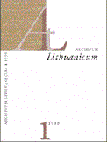Simonas Daukantas – Motiejaus Valančiaus raštininkas
Simonas Daukantas—a Scribe of Motiejus Valančius
Author(s): Giedrius Subačius Subject(s): Language and Literature Studies
Published by: Lietuvių Kalbos Institutas
Keywords: Valančius; Lithuanian; Lowlands; Daukantas; manuscript; text; phonetic; morphology; graphics; orthography; dialect
Summary/Abstract: Motiejus Valančius, a Catholic bishop of the Lithuanian Lowlands, published a book, The Life of Jesus Christ (ŻIWATAS JEZAUS KRISTAUS, 1853), in Vilnius. The original manuscript of this book is preserved in the Library of the Lithuanian Academy of Sciences. Recently I discovered that Simonas Daukantas (the famous nineteenth century Lithuanian historian) had compiled the major part of this manuscript (pages 5-106 and 151-282). Only a few traces of Valančius’ handwriting can be found here and there throughout the manuscript. Some phonetic, morphological and graphic peculiarities help to determine who the real author of the text is. For instance, in other texts Valančius would usually write the digraph <uo> (duok ‘give’), whereas during the same period Daukantas would use only the grapheme <¾> (d¾ti ‘to give’); Valančius preferred the letter <i> and in fact had completely eliminated the letter <y> from his texts (iszpildisiu ‘I will fulfill’). Daukantas, on the other hand, used both letters (gimdymas ‘giving birth’). Valančius made frequent erroneous phonetic reconstructions (hypercorrections) with affricates (kałbanczi ‘speaking’), which were very rare and unusual in Daukantas’ texts. Valančius would sometimes employ the depalatalized consonant letter <ł> before the phoneme /e/, even though the latter vocalic phoneme itself might be rendered by orthographic <a>, e.g., (atłajsti ‘to forgive’), a phenomenon which was not known to his or Daukantas’ native dialect. Daukantas, however, did not do this. In spite of the fact that the manuscript was mostly written in Daukantas’ handwriting, all the aforementioned linguistic peculiarities are common to Valančius’ texts alone. Daukantas preferred other forms. All this means that Daukantas was forced to copy Valančius’ manuscript literally and no hint of Daukantas’ own orthography was permitted. It is obvious that Valančius used Daukantas for his own purposes. When Daukantas was living in Varniai under the protection of Valančius (1850-1855), Valančius simply turned Daukantas into a scribe of his own religious texts.
Journal: Archivum Lithuanicum
- Issue Year: 1999
- Issue No: 01
- Page Range: 85-95
- Page Count: 11
- Language: Lithuanian

